|
SUMMARY OF EVIDENCE
In February 1999, AHRC submitted to us a
compilation of evidence detailing the charge that
militarization has caused food scarcity. Along with a series
of written depositions, it contained history, statistics and
excerpts from numerous reports about Burma’s government
and economy. Also provided were several explanatory maps and
a collection of photographs detailing aspects of the
evidence. After reviewing the compilation, the People’s
Tribunal convened in Thailand to hear testimony firsthand. On
April 2-4 twenty-six witnesses made depositions. We
interviewed nine of these people in Bangkok, and the
remaining seventeen in Tak Province. Most of the depositions
were recorded on audio cassette and later transcribed.
Witnesses who gave testimony in languages other than English
worked through interpreters, and their depositions were later
translated into English for documentary purposes. It is not
practical to insert all the evidence in this report. Instead,
we include a clear and representative sample. 1
 Untold Sorrows: Food and War Untold Sorrows: Food and War 
The evidence demonstrates that food
scarcity is a national trend which varies according to
regional political and economic conditions. Most notable are
differences between areas with armed conflict and areas
without it. Terminology differentiating these areas is
problematic. The government does not use the term "civil
war," preferring instead to consider the conflict an
insurgency by "illegal armed groups." On the other
side, opposition groups see the armed conflict as revolution
or even war for independence. It is outside the
Tribunal’s scope of inquiry to investigate and decide on
the conflict’s political classification; we are
concerned with the relationship between armed conflict and
hunger. In keeping with the general trend of the testimony
brought before it, the Tribunal uses the terms "civil
war zones" and "non-civil war zones," without
bias or obligation to any political significance they might
connote.
| Nevertheless,
terminology problems remain. Civil war zones are
often further divided into "black" and
"brown" zones, the former meaning areas
considered by the government to be outside its
effective control, and the latter denoting areas over
which its control is incomplete. It is widely
reported that this further division, along with the
term "white zone" for areas without an
insurgent challenge, is a fundamental military tactic
employed by the government. Both types of zone
experience consistent human rights abuse.
Furthermore, the term "free-fire zone"
declares an area to be under a form of military
control which allows soldiers to shoot anyone on
sight without the need to determine identity. Again,
the government doesn’t use these terms in its
public documents or mass media. Regardless of whether
these divisions originate from the government, the
Tribunal finds them logical and useful descriptors
for real conditions, and elects to use them here. |
People
are forced into the jungle, hiding their rice and
struggling to survive without medicine, schools or
much contact with the outside world |
 Food Under Fire Food Under Fire 
Remote regions of Burma are exposed to
primitive but militarily effective scorched-earth tactics.
According to Tatmadaw strategy these are "free-fire" areas, in
which all people are suspected of insurgency and are treated
as the enemy. People are subjected to indiscriminate
executions and a panoply of other human rights abuses, mass
destruction of crops and villages and massive population
displacement. The Burmese army has devised what is known as
the "Four Cuts" strategy to deny rebels (1) food
(2) money (3) communication and (4) recruits. In practice,
the strategy does not differentiate between combatants and
civilians. To begin with, selected areas 40 to 50 miles
square are cordoned off for concentrated military operations.
The army then orders villages to move to strategic locations
under its control. Soldiers may warn that anyone who refuses
to move will be treated as an insurgent and can be shot on
sight. After the first visit, troops return periodically to
confiscate food, destroy crops and paddy and
shoot anyone suspected of supporting insurgents.
| The evidence
collected by Saw Kwe Say in respect to Papun and
Kyauk Kyi Townships describes how people are dealt
with in insurgent zones. While the army has its bases
in the lowlands, people are forced to live in the
jungle "hiding their rice and struggling to
survive without medicine, schools or much contact
with the outside world." People say that they
are always on the run for they do not know when the
soldiers will come. They face immense hardship: |

Map 5: Pegu Division
(Click to view full image)
|
| |
|
| "This
year we ran from the army four times. The third time,
they pulled all the paddy stalks from the ground and
burned down the field hut" |
When the army columns come
into the mountains, they destroy any houses they
find, shoot whoever they see, and take or burn all
food and possessions. If they come to a village, they
don’t see any people because everyone has run
into the forest already. If they find rice stored in
the jungle, they take or burn it, or sometimes lay
land mines around it. We always look for a safe place
deep in the jungle to hide our food…These hiding
places may be safe from soldiers, but not from
wildlife. 2 |
Because of these harsh military pressures
in an already difficult natural environment, the villagers
constantly struggle to feed themselves:
| One woman in my
mother’s village was growing rice to feed her
four children. The soldiers came so she abandoned her
small field for a while. As a result the crop
wasn’t very good. Before harvest, a pack of wild
boar came and destroyed about one fourth of her crop.
After harvest, we left the cut rice stalks to dry in
the fields, and the boars came back for another
quarter. Finally, when we were preparing fields for
the next crop they came back again. When she saw what
had happened she just sat down, stared at what was
left of her rice and began to cry. |
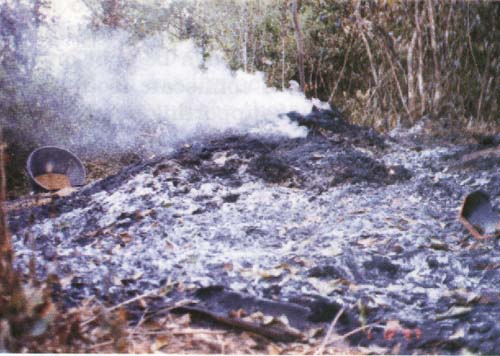
Picture 11: "The rice they couldn’t carry
away, they set on fire
|
Saw Kwe Say appeared before us and
submitted further information he collected relating to a
village called T’kwiso, where villagers said:
This year we ran from the army
four times, and three times in September they really
reached our location. The first time they took all our
possessions. The second time they destroyed all our
crops. The third time, they pulled all the paddy stalks
from the ground and burned down the field hut.
He stated that this year families would
face extreme hardship from the soldiers coming and destroying
the grain and foodstuffs, and also from having to flee.
Displaced people have little forewarning
and little time to prepare food for their stay in the jungle.
Even their food can become a liability, as reported during a
1997 military operation in Kyauk Kyi Township:
The villagers of Nwar Lay Khoh
knew that troops were approaching, so they began to
evacuate their houses. They fled into the scrub,
dangerously close. They had to kill roosters and geese,
because their cries travel far and might reveal the
hideout. For security, dogs too were beaten to
death—there is a lot in the jungle to bark at. 3
According to another researcher, Dee Gay
Htoo, as the army passes through villages it
indiscriminately destroys food. He states that:
The biggest problem is getting
food. Troops have destroyed virtually everything of last
year’s crop and now people are trying to plant, but
there hasn’t been any rain, so the crops are poor.
The suffering is extreme. Most people are living only off
bamboo shoots and other roots.
Dee Gay Htoo filed another report in
October 1998 which details military attacks on other villages
in Papun. For example, in Tei Bo Plaw Village:
| Battalion 706 burned
down two sections of Tei Bo Plaw. Khler Hat Htah
was destroyed on 31 October 1997, and Maw Pho Khi
on 12 November. Twenty-two houses were burned.
The army stayed in Tei Bo Plaw for about one
week. The villagers fled into the forest but
couldn’t take much food. Altogether, 71
barns were burned, and the people lost 3,692 baskets
of grain. 4 |

Map 3: Karen State
(Click to
view full image)
|
In another village, Doh Daw Khi, Dee Gay
Htoo continues,
When the villagers fled, they
couldn’t take very much food with them. They fed
what they had to the children, and the adults fasted.
They went and secretly grabbed food now and then. One
woman gave birth during this time, but the child died,
due to the conditions in the forest. These villagers have
had to hide out there for five months, the entire rainy
season. Most are animists whose religion stipulates that
any place destroyed by fire cannot be rebuilt for three
years.
| In this way, we have details of
several villages destroyed by the army in Papun
region. There is also a report by Karen Human Rights Group (KHRG) which lists 105
villages forced to relocate, 180 burned down and 10
more partially destroyed. 5 |
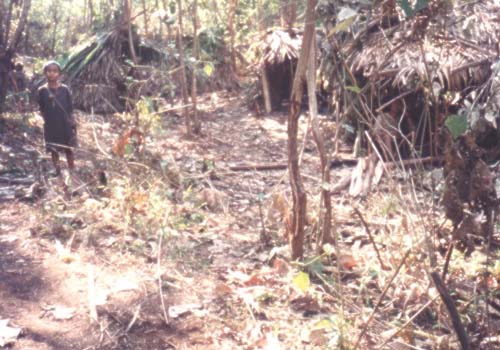
Picture
12: "The people live in fear that the army will
search and find them."
|
From Kyauk Kyi Township we heard similar
allegations of army abuse. Saw Kwe Klo reported that the army
..looted and destroyed property
in every village they entered. They arrived in Nwar Lay
Khoh on March 14, and burned down 32 houses. They ate all
the ducks, chickens and pigs they saw. The people work
swidden farms. The land must be prepared in February, but
because of the army people didn’t come back until
May. This has meant a very poor crop... 6
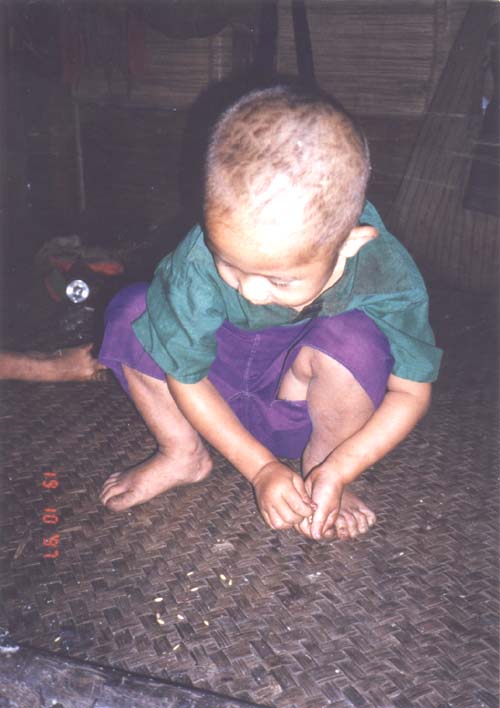
Picture 13: "I saw one family
close to utter starvation,
the two small children crying from
hunger."
|
"The biggest
problem
is getting food.
Troops have destroyed
virtually everything of
last year’s crop...
The suffering is extreme." |
There are many instances of similarly
tragic experiences narrated by villagers. Hunger can force
unarmed civilians into deadly encounters with the army. On 3
April 1997, soldiers entered Thay Khoh Mu Der, whose
inhabitants evacuated immediately
without preparing any food for
themselves. They had nothing to eat in the forest. The
army burned 36 houses and 14 barns containing 200-400 baskets each.
Some villagers decided to come back for hidden rice. Five
men fearfully returned, but the soldiers saw them and
started to shoot. Phar Khin Sein, aged 50, was killed and
the others escaped. 7
Saw Htoo K’baw, a teacher from Papun
Township gave his statement to Saw Khwar Hsit, a Tribunal
researcher.8 They
both appeared before us on April 4. Like most of the people
from his village, Saw Htoo K’baw came to Thailand two
years ago. In his first statement he recalled, "Starting
from January 1992, the Burma army soldiers began to battle KNU there and destroyed
villages. They patrolled and skirmished, and so 1992 was the
first year that there were food problems." However, he
stayed on even when others had left. He gave a year by year
account, starting with his own efforts to earn a living
during the school break:
In January I planned to trade in
biscuits, Ajinomoto and
clothing to get extra money. The soldiers were patrolling
because of this trade, and would stop people on the road
or shoot from far away. As five of us were returning,
some soldiers off to one side of the path saw us and
shot. We dropped our goods and ran for our lives. I lost
all my valuables and was discouraged from trading any
more.
Thus, his search for food was confined to
the village and its immediate environs, which added to
hunger. Starting from September 1994 his family fled the army
frequently and
had to eat rice porridge for two
months. After October we reopened the school, but on
weekends I found work sawing timber in order to buy rice.
I didn’t even want to plant rice anymore at that
point. Sometimes all we had to eat were boiled bamboo
shoots and roots.
Eventually, Saw Htoo K’baw took up
farming again, but his efforts to grow rice were continually
frustrated by military action:
It was almost harvest time when
we fled to where there was no food. We had not brought
much with us, so we ate porridge. For two or three months
we hid like that, and my fields were destroyed.
By 1996, conditions had become miserable
for the whole village. As an immigrant to the area, Saw Htoo
K’baw wasn’t adept at hunting or foraging for wild
roots and vegetables, which is how the indigenous people
coped with hunger. He turned to his neighbors for charity:
| I would forego food so
my children could eat. I went around begging for
rice. Some people took pity and gave me a cup or
two. Most who had migrated to the area like me
were suffering considerably. |
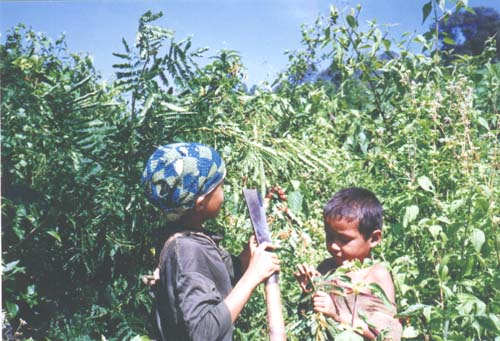
Picture
14: "In the jungle we had to eat roots and
leaves."
|
His family continued to survive without
food security, but conditions were dire. In 1996 they took to
the jungle three separate times, during which he saw others
suffering an even worse fate:
Each time we had no food. In the
forest relationships varied. Some shared food with others
then left to look for roots together; others did not. I
saw one family close to utter starvation, the two small
children crying from hunger. The mother pitifully fed
them roots which hadn’t been boiled long
enough—she probably didn’t know what else to
do. After that they suffered nausea, vomiting and
diarrhea.
Eventually they could withstand no more.
Losing their home was the last straw:
Around April, it rained very
heavily and our house collapsed into the river, totally
destroyed. We were left with nothing, no food and no
place to stay, so we fled and hid. My children were sick.
A KNU
official gave me some rice. I thought about the situation
and knew we couldn’t stay there anymore, and so we
came to this refugee camp.
When we met Saw Htoo K’Baw in April he
testified that between 1994 and 1996 up to thirty children,
mostly under 5 years old, died from malnutrition. We asked
whether he would go back, and he answered:
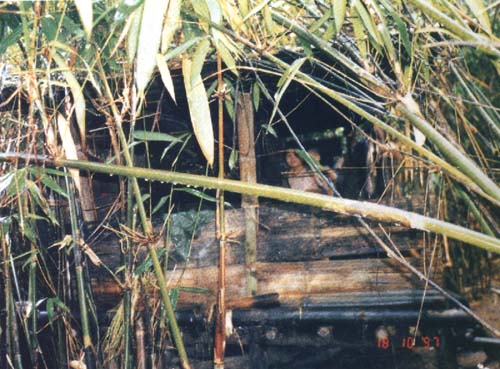
Picture 15: "We cannot go back, we dare not go
back and face the soldiers."
|
Everyone wants to go back,
but is afraid. Even if we went and there were no
soldiers, we would still have a food problem in the
first year or so. Also there are a lot of landmines,
planted by both sides. If there weren’t mines,
it would be more feasible. |
We have videotaped statements from several
people in Papun, all narrating the same story of destruction
and flight.
Another informant told a similar tale of
military abuse in Myawaddy Township, who reporting that when
soldiers came they
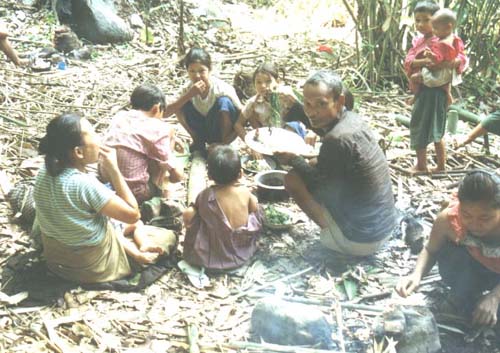
Picture
16: "In the forest relationships varied. Some
shared their food with others then left to look for
roots together
|
ate our pigs and chickens.
Anything that they didn’t eat, they killed, and
the rice they couldn’t carry away, they set on
fire. Day to day, we could still eat, but over a
longer time we would surely have starved. Because we
couldn’t travel around, we couldn’t work.
We always had to follow their orders. My children
suffered from diarrhea and malaria. So before my
family reached the point of starvation we fled to
this refugee camp. If I had stayed in my village I
would surely have died. There were still 20 baskets of
threshed rice in my barn. I had to leave all that. 9 |
The above evidence comes
from Karen State, but conditions are similar in central and
southern Shan State. AHRC’s
compilation shows that since March 1996, the Tatmadaw has
forcibly relocated over 1400 villages through 7000 square
miles. Over 300,000 people have been ordered to move at
gunpoint into strategic relocation sites. The relocations
intensified in 1997 and 1998, with people in new areas forced
move, and existing sites forced to relocate yet again. Vast
areas of 11 rural townships have become depopulated
"free-fire" zones. One witness described to us
relocation in Shan State:
Three to five days after the
order, soldiers come back. If villagers haven’t
left, either they say ‘go now,’ or burn the
village, or shoot—there are many different
scenarios. Out of 300,000 people, 100-120,000 have come
to Thailand. About 100,000 are in relocation sites, and
about 50,000 are on the outskirts of towns where they can
find work or have relatives. About 50,000 are hiding.
They are trying to survive in the jungles. 10
The Tribunal also heard of a family’s
struggle with relocation, hunger and violence in Shan State.
Her family
| was relocated to Kun
Hing in 1996. They went to the relocation site
and tried to stay, but couldn’t. They went
back into hiding after a year, on a heavily
wooded island in the river. Her father would
catch fish at night then secretly go to Kun Hing
to sell in the market. Just last month he went
back to his old village to look for cattle he
left there. He was shot and killed. The family
lost their breadwinner, so they moved to Kun Hing
and the mother sent her to Thailand to earn
money. |
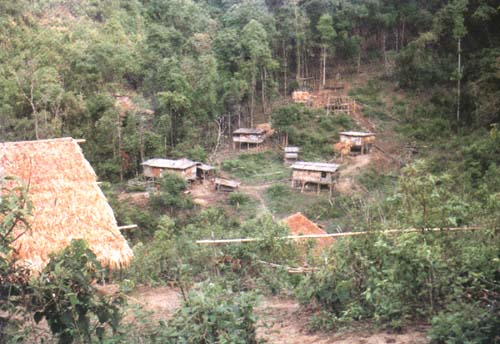
Picture
17: "People are forced into the jungle,
hiding their rice and struggling to
survive."
|
Villagers in the relocation sites work as
porters, build roads, dig ditches and erect fences at nearby
military camps without food or pay. Most of the relocated
people are farmers; so all these changes have seriously
affected regional food production.
Similar is the situation in
Karenni State. The Tribunal heard that
large numbers of Karenni farmers currently live displaced.
Some have moved to the relocation camps; the majority remain
hidden in the jungle; and some have fled to refugee camps in
Thailand. Many see no viable option in Burma and migrate to
Thailand to live as refugees or illegal migrant workers.
The relocations about two years
ago in Karenni State involved 70-80,000 people, entire
regions were moved. People had four choices: 1) go to the
relocation site, under Burma army control; 2) stay with
relatives in town; 3) hide in the forest; 4) cross the
border into Thailand, the last resort. The vast majority
of people don't want to come. Many went to the relocation
site at Shadaw. Now, two years later, people are arriving
in Thailand because they simply could not survive. They
tried. There are people who said their father starved to
death, people who said, "This does not happen in
Burma, people do not starve." They tried to make
ends meet, they cannot any longer, and they come to the
border. 11
The AHRC has summarized how the civil war
creates food scarcity. It identified six factors:
- Direct
attacks on civilians and food
Military offensives destroy villages, farms, grain
and livestock. Food is consistently targeted for
destruction. Civilians displaced by combat who return
to their fields risk being shot on sight. Some
communities are attacked more than once within a
year.
- Looting
of food and possessions
Soldiers take food and livestock without permission
and loot other household possessions.
- Displacing
people
Civilians flee to the jungle, become internally
displaced persons (IDPs), and face food shortages.
Army columns destroy any hidden food they find.
People hide in the jungle as long as they can. When
they can no longer survive this way, they try to flee
from the area completely.
- Restrictions
on trade and travel
The army cuts trade and transportation routes to
"black" zones, creating shortages of food,
medicine and other essentials. Civilians are also
denied income through trade.
- Ecological
damage and crop shortfalls
Frequent military incursions diminish soil fertility
by preventing farmers from preparing their fields
properly. Military action also interferes with
planting, tending and harvesting crops. Therefore,
farmers produce a shortfall of paddy and other food.
- Poor
health
Civilians, particularly children, suffer from
malaria, diarrhea, anemia and malnutrition. The
evidence links child mortality to food scarcity.
Non-government clinics in "black" areas are
military targets, and trade in medicines is
prohibited, thus denying treatment to the ill.
 To Live, to Work, to Eat To Live, to Work, to Eat 
In areas not entirely controlled by the
government, we find systematic population displacement and
forced labor, arbitrary taxation, extortion and other
infringements on basic economic rights.
The Tribunal heard testimony about the
typical problem of two or more armies vying for
administrative control. According to a woman from Mon State,
military demands piled up with each new regime:
The village was taxed by KNU for a
long time, though there were some benefits, such as
schools and clinics. When the Burma army came it also
made demands, but if fields were not destroyed then we
could pay. But with the advent of DKBA in
1996 food problems have grown. 12
Similarly, we read evidence of how
civilians are caught between insurgents and the government.
In 1996, the Tatmadaw announced the following fines and punishments
people in southern Burma’s Thayet Chaung Township:
- Any
village where insurgents fire a gun must
relocate within seven days.
- If
insurgents attack Tatmadaw territory, all
villages through which they passed must move.
- If
any Burma army soldiers die in combat, the
nearest village must pay compensation of
50,000 kyat for each
dead soldier.
- If
insurgents take Tatmadaw equipment or food,
the nearest village must pay to replace it.
- If
Tatmadaw loses guns, the nearest village must
pay 15,000 kyat for each.
- Any
village where a battle takes place or where
insurgent supporters are exposed will be
burned to the ground. 13
|

Map 6: Tenasserim Division
(Click to view
full image)
|
Most of Tenasserim Division is a contested
area. AHRC has submitted that severe military action since
1997 has displaced much of the rural population. These
effects have been documented in various reports such as
"Tennasserim Situation Report" (1998) by the KNU Mergui-Tavoy
Information Department and "The Situation of the People
Living in the Gas Pipeline Project Region" prepared by
Mon Information Service (1997). All detail how villagers were
conscripted for forced labor on development projects under
appalling conditions. Moreover, they had to feed themselves
while doing it. Much of this farming population has either
been forcibly relocated or if not, subjected to severe
restriction of movement. Many are prohibited from staying
overnight in their fields, necessary during the
labor-intensive planting and harvesting seasons.
We received statements on the fear created
by this constant military presence. Naw Ble, a subsistence
farmer in Dawei
township, reports that she returned home after the army
promised not to harm villagers:
| We saw all our
possessions scattered, and no cock crowed, no dog
barked, no cat cried and no cattle wandered about
the place. Everything was quiet. The next day,
troops started to dig trenches by our houses.
They did not harm us, but would climb our trees
and take fruit. They ordered us not to leave the
village without permission. To go out cost 15 kyat
per day, and we had to be back before dark. 14 |
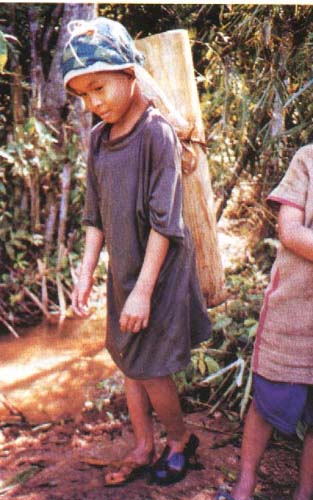
Picture 18: "It was almost harvest time when
we fled to where there was no food.
|
We found that counter-insurgency measures
include the confiscation of food from civilians. The same
witness related how her village’s food was taken away:
| After wandering in the
jungle we felt there were no more places to go.
Some people suggested going back would be better
than being caught in the jungle. So one day when
there were no soldiers in the village, we
re-entered… They ordered us
to bring our paddy from where we hid it, or they
would find and destroy it. Some brought the rice
and it was confiscated. The soldiers ate it. At
the same time, soldiers went house-to-house
selling ration rice for 50 kyat a pyi.
We pay to work our own plantations, we serve them
without wages, our paddy is looted then we buy
back rice to survive. Our fruit and crops are
taken, our animals and plants are taken, we are
unable to escape. They told us troops in the
hills have orders to kill anything they see. We
are haunted by this.
|
"We
saw all our possessions scattered, and no cock
crowed, no dog barked, no cat cried and no cattle
wandered about the place" |
This treatment by the military naturally
created resentment among the people. Another villager
complained:

Picture
19: "They ordered us to bring our paddy from
where we hid it, or they would find it and
destroy it."
|
I feel bitter about the
troops staying in our village, looting our rice
and eating it, then selling us their rations. We
have very little money to buy rice. Think about
it! How long can you survive without any time to
earn money? 15
|
Adjacent to combat zones, "brown"
areas are a constant source of conscripted labor. The army
forces people to work continually, a practice well documented
by international organizations. The International Labour
Organization’s exhaustive report commented on the
economic ramifications: 16
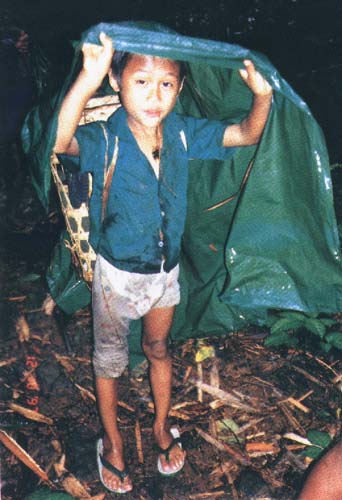
Picture
20: "We slept soaked."
|
Forced labour caused the
poorer sections of society who carried out the
majority of the labour to become increasingly
impoverished. Day labourers needed paid work
every day in order to obtain sufficient income
and that became impossible when they were forced
to provide uncompensated labour. Families who
survived on subsistence farming also required
every member of the family to contribute to this
labour-intensive work, particularly at certain
times of the year. Demands for forced labour
seriously affected such families. Families who
were no longer able to support themselves often
moved to an area where they thought the demands
for forced labour would be less; if this was not
possible, they would often leave Myanmar as
refugees. Information provided to the Commission
indicated that forced labour was a major reason
behind people leaving Myanmar and becoming
refugees. |
Furthermore
porters on duty go hungry, as recounted by this 18 year old
from Kawthaung Township who was forced to carry loads for an
army column in 1997:
All the
porters became weak from lack of food. I saw about ten
fallen by the way, some were ready to die, rolling around
and murmuring. Some had swollen faces and heads. Seeing
this I was afraid, since I was weak and could not walk
well. I wanted to run but did not know the way, so I
carried on even though weak and thin. 17
Another porter serving at the same time
echoed this ordeal:
They fed us two cups of rice a
day, along with salt and sometimes banana palm shoots.
The soldiers had enough rice, curry and canned food. More
than 100 porters slept in a shelter we built ourselves.
The roof was made from old iron sheets. When it rained
the roof did not cover us, so we slept soaked. There were
so many sick porters among us. The military didn’t
care for the sick. 18
| We also saw a report on Palaw
Township, where the people are caught between the
Burma army and KNU. The Tatmadaw suspects villagers of helping
KNU and targets them for all sorts of torture,
extortion, and confiscation of food. Thus, many
villagers are hiding in "free-fire" zones.
These people live in fear that the Burma army will
search for them and find them, especially in the dry
season. In fact, in the 1998 dry season troops
destroyed many jungle plots, and barns, livestock and
property were confiscated. The main concern of these
internally displaced people is food. The AHRC has
also collected several statements from the affected
persons. 19 |

Picture
21: Many villagers are hiding in
"free-fire" zones
|
We read case studies from Bilin Township
and Pegu
Division. These are areas where people have been forcibly
relocated. According to one relocated villager, arbitrary
taxation, forced labor and restricted movement result in food
scarcity:
Most villagers travel two or
three hours to work their farms. Traveling back and forth
they can’t really tend their crops, which get
damaged by disease, insects and weather. Soldiers moving
from one place to the next also trample the fields.
Swidden fields must lie fallow before being used again,
but because of relocations more people are forced into a
small area, so soil quality is deteriorating. Before the
harvest is in most people eat rice porridge, perhaps once
per day, with a few bamboo shoots, with parents going
hungry so children can eat. 20
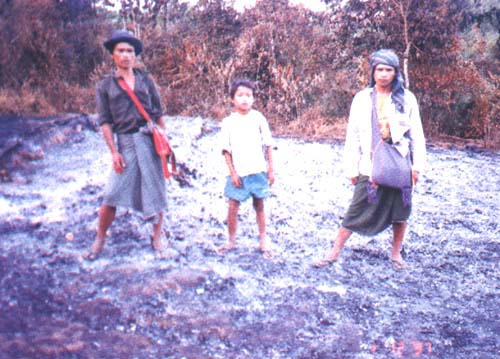
Picture 22: "They threaten that if anyone shoots
at them in the village, then it will become
ash."
|
We also saw evidence of how
soldiers ordered farmers throughout eight villages to
pay "gardening taxes" on their own trees.
The fees were calculated as follows: 18 kyat for each
betel palm, 10 for a coconut palm, 15 for cashew, and
5 each for mango, jackfruit, pomelo and lime trees.
The army threatened the villagers that failure to pay
meant land confiscation.21 |
AHRC identifies nine conditions which cause
food scarcity in such areas:
- Direct
attacks on civilians and food
The army attacks civilians and food less frequently
here than in black zones, but burning of food, houses
and fields continues. Populations deemed
uncooper-ative experience the worst forms of military
excess.
- Expropriation
of food, possessions and land
The
army constantly demands rice and livestock, either
without paying or paying little. Soldiers resell
military rations while living off food stolen from
villagers. Bullock carts are confiscated for work on
infrastructure projects. Agricultural land is taken
for roads, plantations, barracks or military-run
development projects.
- Relocation
Forced
relocation of villages is common. Movement at
relocation camps is tightly restricted, while former
village sites are declared "free-fire"
zones. Trading may be prohibited. Farmers are denied
access to their fields. Those who flee relocation to
hide in the jungle expose themselves to free-fire
conditions.
- Forced
labor
The
army conscripts unpaid labor on infrastructure
development projects. Villagers perform menial duties
for the military and portering increases. People have
not enough time to work for themselves, and
self-sufficiency in the rural economy dissipates.
- Taxation
and fees
Furthermore,
the army levies arbitrary taxes and fees, including
fines for defaulting on labor conscription. These
payments cover expenses, surcharges and fines imposed
by local authorities.
- Crop
procurement
In some areas, the military enforces a version of the
national paddy procurement system (discussed below),
straining rice supplies.
- Rice
rationing
The
army confiscates and stockpiles rice, then rations it
back to farmers. Restrictions on movement, distance
between army camps and relocation centers or
villages, and corruption prevent these rations from
reaching civilians.
- Abandoned
farmlands
Economic
and military pressures force many farmers to leave
their land. The quality of vacated land deteriorates
rapidly, so that it may not be successfully replanted
immediately.
- Inadequate
health care
Stringent control on travel, possession of medicine,
and a general lack of services means that health care
is very poor. Existing clinics may have no trained
staff or medical supplies.
 No War, No Peace No War, No Peace 
| We also heard evidence from beyond
the areas of conflict. In Burma’s non-civil war
zones, failed agriculture policies and persistent
demands for cash, goods and labor undermine food
security. Witnesses testified to rising prices,
falling wages, unbearable taxation and the inability
to feed one’s family. We divide the evidence
into rural and urban areas. |
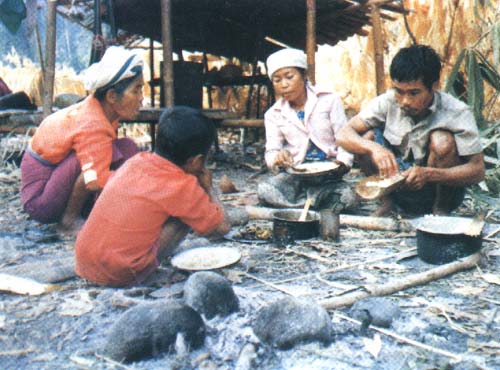
Picture
23: "Most villagers travel two or three hours to
work their farms."
|
 Trouble in the Rice Bowl Trouble in the Rice Bowl 
We heard myriad evidence attesting to
hardship in rural Burma created by government agricultural
policy, especially regarding production and distribution of
lowland paddy.
Much of this data comes from lower Burma: Mon State, Pegu
Division and Irrawaddy Division.
A 24 year old landless worker from Mon
State’s Thaton District described how taxation,
government policy and forced labor created hunger in his
village
This is a general description of
my village since 1988, but things have been worse since
1996 than any time before. The village has only about 18
real landowners, and the rest are hired workers. The
biggest farm is 50 acres. I worked on a 13 acre holding,
which yielded 60-70 baskets of
rice per acre, as long as we used fertilizer.
High taxes and hunger forced
some farmers to sell their land. They have to pay
the annual quota, which the government buys at 150 kyat per basket. The
administration had us build a big dam, and to support
this work farm owners paid one more basket per
acre annually to the township council. The dam
construction began in 1992 and took two years. The water
is for the dry season crop. The dam needs maintenance,
and if you don’t go you are fined 100 kyat per day.
Government plans to increase rice
production included chemical fertilizers and farm machinery
as well. Because of corruption, however, farmers did not
benefit from these enhancements:

Map 4:
Mon State
(Click to view
full image)
|
The Ministry of Agriculture and
Irrigation sells two kinds of fertilizer which farmers
can buy on credit at 3,200 kyat per
acre. But our township council prefers selling to
merchants, leaving farmers with only 4 bags for 10 acres.
But when the debts are due, farm owners have to pay the
full value, as if they had actually received 2 bags per
acre. We heard that the government sent irrigation
pumps, but after the township council received them all
the pumps disappeared. |
Apart from farming, the
people must work on a variety of projects run by the
military. Some, such as roads, are public works projects,
while others seem to be soldiers’ private concerns.
| Villagers build roads
without pay. If you don't go, the soldiers make
you a porter to the frontline. IB
33 Commander Aung Ye Min established a rubber
plantation on 500 acres near the village. The
army made people plant trees then fence in the
plantation. Cattle used to graze there, and now
if they stray back the soldiers shoot and eat
them. |
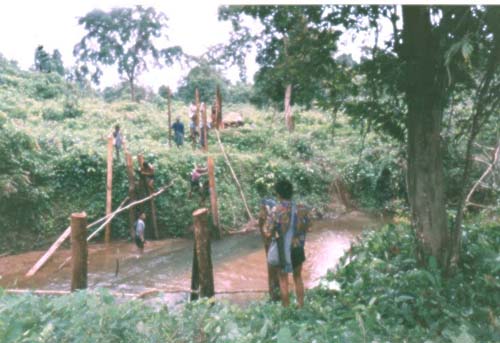
Picture
24: "Villagers build roads without
pay."
|
So, even without
insurgency, rural people face local military rule and hunger.
The witness described food scarcity in his village:
Taxes and oppression are
starving the village. There’s no time to work, only
to pay taxes and do forced labor; many villagers have
little food. Some must eat porridge, some only water
skimmed off boiled rice, and others only sweet potatoes.
To feed the children some adults go without food for
one or two days at a time. Even so, children increasingly
suffer diarrhea, sore stomachs, and death.
| "They
said, ‘If you can't stay then get out—we're
just following instructions. You farmers are
dishonest. When you need something we give it, then
you protest. We can't follow your whims any
more’." |
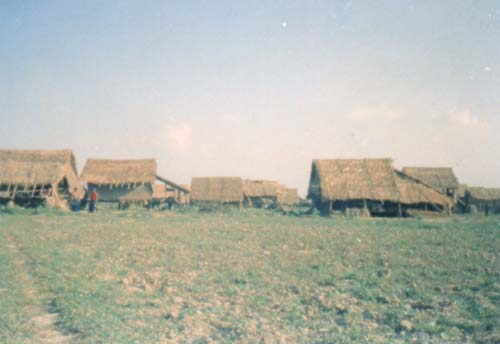
Picture
25: "Taxes and oppression are starving the
village."
|
Living under these
conditions, the informant’s own family did not eat
adequately. Food security eluded them, despite their
collective efforts. In the end, he left home to find work
abroad:
I have 5 children. My oldest
daughter, who is eleven, always went to do forced labor
while we parents looked for food. You see children 8 or 9
years old working. Sometimes we only had enough rice for
porridge. I worked all day, then went home only to hear
my children cry from hunger. My tears fell, too. I could
not suffer the poverty of my village. I came to Thailand
to work and send money home, so that they can eat.
22
We read the statement of a
58 year old widowed farmer from Rangoon Division. This very fertile area
had always enjoyed a rice surplus. She related the hardship
caused by government policies to increase rice production
through irrigation and double cropping. The drive to grow
more paddy began with forced labor:
The government made us dam the
Ngamoeyeik River then called on us to grow summer paddy.
The construction site was 5 miles away, and we walked
back and forth every day in the hot season, when it was
really stinking hot. Each family in the region had to
send people to dig. I heard that one pregnant woman died
carrying loads of soil on her head. I had to hoe the
ground. The work was enormously tiring. After we went
home in the evening, they videotaped the day’s
progress. The dam opened in 1995. 23
The dam now complete,
farmers had to adapt to the hastily-planned new crop:
Summer paddy started in 1996.
They didn't give seeds, we had to buy them. I'll tell you
something, they made us buy seeds taken from other
farmers. But different strains of rice were all mixed
together, one from here, one from there. When we planted
we didn't notice the difference, but they grew at
different rates. There were three different kinds of
rice, so what can you do about that? You can't do
anything! You would have to harvest one field three
different times, which is too much work. Farmers were
furious—some destroyed the whole lot and planted
beans or sesame, then bought paddy in the market for
their quota.
Despite these initial
setbacks, the government enforced the summer crop program.
Farmers were forced to comply:
Well, by this time most monsoon
paddy had been harvested, and people had planted their
beans. But with the dam finished everybody had
to grow summer rice. They told us we couldn't grow nuts,
we had to grow paddy. Officials from Rangoon, not
soldiers, came and ripped up the beans and even
unharvested rice. That was just about the last straw. The
government said, "We are making you grow summer
paddy for you yourselves to eat." They said monsoon
paddy is for government and summer paddy would be for
farmers.
But flaws in the program
continued to frustrate farmers and government alike,
particularly irrigation problems:
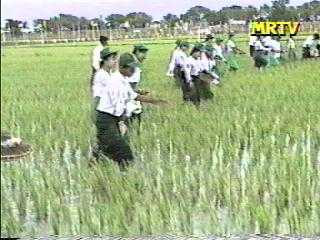
Picture
26: "The summer crop is a total loss for
farmers, but if you don’t do it, the government
will take away your land.
|
When we needed water they
didn't open the dam; when we didn’t want water
they gave it! At first they didn't release water as
some people hadn't finished harvesting all of their
crop. Summer paddy needs water, so the government
opened the dam and way too much water poured out.
People who hadn't finished harvesting their first
crop rushed out to gather it all up. In bean fields,
water flooded the landscape. Villagers asked,
"What are you doing? We can't even live here any
more." Then the government answered "If you
can't stay then get out—we're just following
instructions." Later they cut the water and the
summer rice started drying up in the fields. People
ended up pumping in water themselves, which was
expensive. The administration said, "You farmers
are dishonest. When you need something we give it,
then you protest. We can't follow your whims any
more." The authorities said farmers are
inconsistent and don't do things right. |
Eventually, farmers
confronted the state:
| Farmers were now losing
their crops. So villagers went to break open the
dam themselves. The authorities became
angry and said, "You went to break open this
dam, so you must relocate!" The village
leaders outlined their case step by step, then
the authorities understood a little. We didn't
have to relocate, but we had to help repair the
dam. We nearly died in the stinking hot weather.
Anyway, it was all flooded and the paddy was
dead, dead, dead. They took video where the crop
looked good, where it was green and ripe. They
don’t shoot the stuff that didn't
grow—you can't say anything about that. The
wet paddy smelled foul. The procuring agents
refused to take it. Nobody is producing enough
grain. No farmer has enough to eat. This is what
I know from my own experiences and what I myself
have witnessed. |
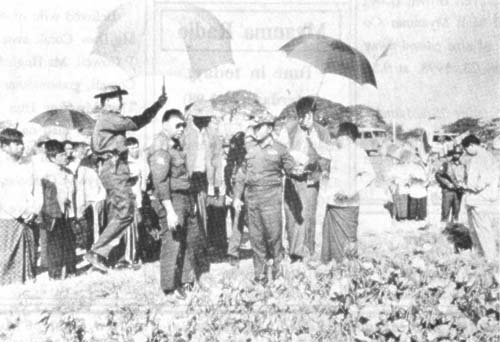
Picture 27: "The government said, ‘We
are making you grow summer paddy for yourselves
to eat’."
|
Amid this fiasco, farmers
still struggled to meet the rice quota. The widow’s
family faced insurmountable problems:
My son-in-law and I owed 80 baskets to the
government. His 6 acres produce about 200 baskets in a
good year. But this year he got less. The government
calculates quota by stripping stalks until the grain
fills a tin can. Where there's dense growth two or three
stalks will fill a can. They said that one acre would
produce 80 to 90 baskets. That's what they said... 80 to
90 per acre, compared with 200 for the whole farm in a
good year.
Our land was flooded, so we
hired a pump. He had only about 60 baskets left, which we
took to the administration—the entire lot, and not a
single basket was left. But they said, "This grain
is no good, we don't want it," and they made him
bring it all back.
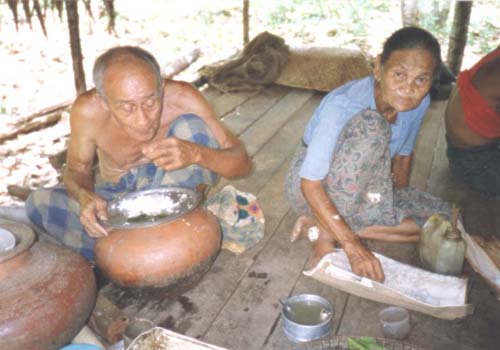
Picture 28: "No farmer has enough to
eat."
|
Farmers now mix in dirt
and other stuff to increase the weight, so even
10 to 20% contain junk. Others bribe—a
couple of bottles of alcohol and maybe they get
10 baskets off the quota. Now
I've come to Thailand to do some trading, sell
medicines and stuff, instead of working there.
There's nothing to be gained from it.
|
While Rangoon Division’s "rice
bowl" is under extreme pressure to increase output,
farmers everywhere face the quota and forced labor on top of
debt and natural disaster. A Dawei Township farmer with four children
said:
I have 3 acres. Last year there
was a big flood and my entire farm was destroyed. I
replanted, but only got 130 baskets, instead of the
normal 200 to 250. We have to pay 12 baskets per acre as
quota, so that was 36 baskets. Because of the flood I
planted twice, so costs doubled. To pay and still meet
the quota meant I couldn’t even feed my family. I
was conscripted as a front line porter for five months,
during which my family had nothing to live on. The only
way was to borrow money. That is why we, the people,
never get sufficient food, never develop. Several in my
village have not been able to repay debts, and have
watched the government confiscate their land and transfer
it to other farmers. 24

Picture 29: "Now days many people have quit
farming because the government forces them to
raise cash-crops for export."
|
"I
was conscripted as a front line porter for five
months, during which time my family had nothing
to live on." |
We learned that the
government forces people to raise crops for export even when
they have nothing to eat. We read about this practice,
environmental problems and poverty in the Shan State:
Central Shan State around Hsi
Paw and Hsen Wi has big paddy plantations. But now days
many people have quit farming because the government
forces them to raise cash-crops for export. Paddy also is
becoming less beneficial for farmers. Agriculture
Department officials push new strains of rice unsuited to
the soil and cool weather. They also push soybeans and
peanuts as cash crops. But peanuts drain fertility, and
the soil must be left to regenerate or it will be
useless. The government pays less for produce here than
in central Burma. For all of these reasons, people are
quitting the land.
It seems that government
input to agriculture had always created problems. We read how
the BSPP failed to invigorate the land:
During the BSPP period,
especially in the early 1980s, farmers traded paddy for
chemical fertilizers under the quota system. At first,
crops were good, but over time the soil deteriorated and
the produce lost its flavor. More fertilizer was required
to get the same yield. Now much of this land no longer
produces; the chemicals caused permanent damage.
Nowadays, the only chemical fertilizer comes from China,
and only big landowners can afford it. Large areas once
cultivated in Hsen Wi are now barren, commodity prices
are rising and people are hungry. Disused land is taken
by the army.
We also have a report about
hunger in Arakan State, where the Muslim minority,
known as Rohingyas, are generally denied Burmese citizenship
and have been repeatedly swept into refugee camps in
Bangladesh. International human rights organizations noted:
Since most of the Rohingyas are
unskilled day laborers, one day of work without pay can
mean one day without food for the whole family. The
availability of work depends very much on the
agricultural cycle, and during summer there tends to be
very little work. In the past, Rohingyas traveled to find
work in towns, but since 1991 their freedom of movement
has been severely restricted… They thus have very
few sources of income to begin with, and since the dry
season also happens to be the best time for construction
work, when forced labor demands are most intense, the
burden on the Rohingyas is particularly acute. 25
All the above evidence
demonstrates food scarcity’s prevalence. However, we saw
that hunger is not only widespread, but also serious. It has
caused malnutrition and death in children, and increased
poverty for the whole family. An informant from a fertile
region of the Irrawaddy Division, recorded hunger’s
impact in his neighborhood.
In 1993 three children died a
couple of doors down from my house. All boys, they were
around 10, 8 and 6. The children had always been weak and
malnourished, especially in the last couple of years.
Their bellies were distended and their ribs stuck
out—like starving African children we saw in
magazines. Their knees were swollen and their calves were
sticks. Their skin was white, their lips pale. They often
had diarrhea. Their father worked cutting grass and
bamboo to build houses. They all died about a week
apart—I remember because I went to cut timber for a
week, came back and heard one had died. I went back to
the forest, came home the next week and another was gone.
Just one week later the third child died. We knew the
family well. I remember the family’s condition and
how this all came to pass.
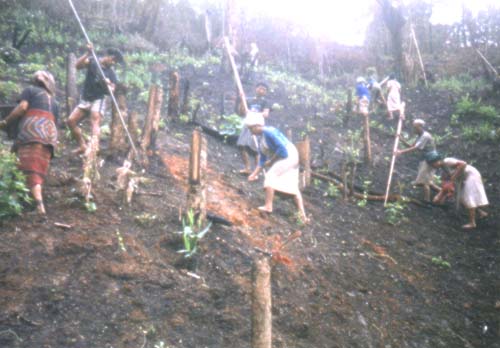
Picture 30: "The soil must be
left to
regenerate or it will be
useless."
|

Map 2: Irrawaddy Division
(Click
to view full image)
|
Before they died, the
children were hungry for many years. Their family was caught
up in a political and economic crisis going on far outside
their village.
| "The
children had always been weak and malnourished,
especially in the last couple of years. Their bellies
were distended and their ribs stuck out—like
starving African children we saw in magazines." |
Their father used to grow
bananas, cucumbers, and watermelons on a small plot
about two miles outside the village. After the 1988
uprising, the government consolidated the village, so
the family had to move. Wild elephants ate all their
plants, and so he turned to cutting bamboo. He earned
about eighty kyat
per day, which might have been enough, but he only
got cash when bamboo traders came, so the family
sometimes went hungry. Also, at 45 he was getting
arthritis and couldn’t work every day. His
family of seven ate no more than mine of five, and my
children were younger. They begged for help
frequently. Of course, we pitied them and helped as
we could. Apart from rice, my wife gave them salt and
fish paste. When the children got
diarrhea nobody suspected anything serious. They took
some Burmese medicine, but that didn’t stop it.
Intravenous drips might have helped, but those cost
150 kyat or
so, and nobody could afford them. So they passed
away. The parents knew their children were dying, but
there was no health care or medicine. Their father
could only weep, heartbroken.
|
Reflecting on these tragic
deaths, the informant commented on the government’s role
in food scarcity:
I knew this was a wrong and
terrible thing. In my opinion, these children died from
starvation. If they had adequate food they wouldn’t
have died. And they weren’t the only ones, but I
don’t know the others’ details. In nearby
villages there was a minor epidemic. No matter how deep
in poverty, people are never excused from demands for
labor and money. This family had no alternative but to
struggle for survival every day, and so the children
died. 26
These narratives represent
the evidence presented to us. They are but a sampling of the
voluminous documentation we received. The next section
presents the last source of evidence we considered,
Burma’s cities and towns.
 Hunger in the City Hunger in the City 
Food scarcity also affects
Burma’s cities. The Tribunal heard of high food costs,
endemic corruption, forced labor, and dislocated rural
villagers drifting into cities in search of work or simply to
beg for food.
The cost of food rose
steadily through the 1990s. By 1998, most poor families in
the capital city could manage only one meal per day 27, though food security was by no
means elusive only to the urban poor. In January 1997 a
former office worker from Rangoon reported,
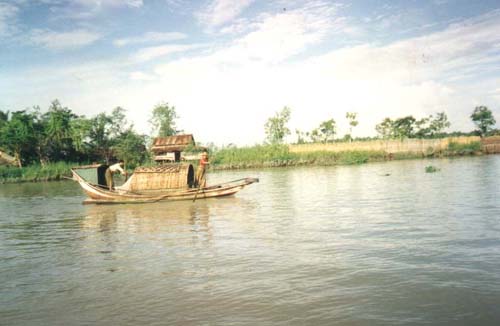
Picture 31: "We have to tell lies in order
to use our own property."
|
The biggest problem is
feeding our families. Nearly everyone in Rangoon
is struggling just to eat. Since we need money
for other things as well, usually we eat less or
eat very simply. This is a general economic
condition, not the problem of only poor people.
My house, for example, could be called
middle-class, but we face the same problems with
food as everyone else. 28 |
Poor urbanites earn their
food one day at a time:
Sundry workers include petty
vendors, tri-shaw drivers, hired laborers, and the like.
They earn between 50 to 180 kyat per
day, barely sufficient to cover the cost of rice. They
purchase only 2-3 pyi at
a time. Agricultural laborers working for the
government get only 20 kyat per day, but have the
privilege of purchasing 12 pyi of polished rice
for only 20 kyat. Sometimes they get afternoon meals
free. Most are women and teenage children. Only the
combined income of all members in a household enables
people to survive. 29
Civil servants
fare no better. While they may receive some benefits,
their income is sapped by a range of petty fees:
thirty kyat for monthly charge for volunteer fire
watch, fifteen for porter fees, two hundred for rice,
twenty for assorted benefits, ten for special
consumer discount rights, fifty to support festivals,
and two hundred for electricity. Half of one’s
salary may be lost to such fees.30 Compounding this loss are
stagnant wages from the government. Even a
substantial pay raise in the early 1990s was lost to
inflation:
That the government has
basically kept wages fixed only exacerbates these
conditions. A 1993 wage-hike averaging around 30%
for all civil servants has not helped to prevent
the slide in real wages. The official CPI was
running at 30% annually between 1989 and 1993,
and has risen since then. On the basis of private
estimates, prices of basic necessities in the
unofficial/black markets in Rangoon
and other major cities across Burma have been
rising at an average annual rate of over 100%
since 1989.
31
|

Picture 32: More visible are the social symptoms of
food scarcity: poverty and children dropping out of
school to work.
|
Government workers struggle
to eat in ways which affect everyone else. The Tribunal heard
that, perhaps inevitably,
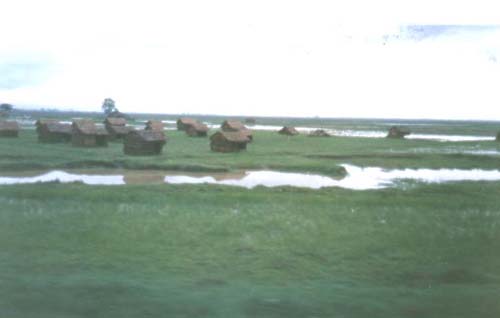
Picture 33: "I saw people fleeing or being relocated
to the outskirts of town.
|
bribery and corruption are on
the rise. Civil servants are more interested in getting
outside incomes, looking for perks and extra cash from
their jobs, and any chance to leave for better jobs
outside the civil service. Private companies pay better,
especially foreign companies. An ordinary civil
servant earns between 900 and 1200 kyat per
month. Despite the discount rice they can not keep up
with inflation. 32 |
"An ordinary
civil servant earns between 900 and 1200 kyat per month.
Despite the discount rice they can not keep up with
inflation." |
A witness from Shan state
told us personally how poverty and corruption among
government teachers affects the nation’s education
system:
In 1988 we moved to Taunggyi,
but the education system wasn’t good there, the
teachers weren’t very enthusiastic. Because they
needed extra income, in the classroom they didn’t
teach the full curriculum. To pass the exams, students
had to pay the teachers for extra tutoring.
As in rural areas, these
various expenses and fees compound the authoritarian demands
by the government. Though the cities may at first glance
appear free from military pressure, security is not
guaranteed. The witness continued:
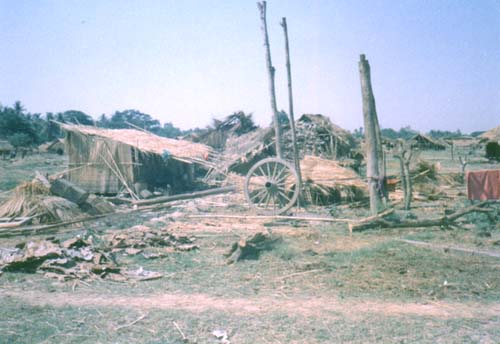
Picture 34: "When I was young I didn’t know
why they all came, but later I learned that no
villages were left in the surrounding countryside;
they had all been relocated."
|
In Taunggyi the government
widened the roads. People had their land confiscated
and their houses demolished. My family lived in a
small town and was never forced to relocate this way,
but every day I saw people fleeing or being relocated
to the outskirts of town. Nearby villages had to
relocate to suburbs, one or two miles out. When I was
young I didn’t know why they all came, but later
I learned that no villages were left in the
surrounding countryside; all had been relocated. When
I left, there was only one army camp, on a hilltop. I
went back to visit in 1994 and saw that outside the
two were many new military camps, set up on land that
used to belong to the people. |
AHRC has listed seven factors causing
hunger outside the war zones:
- Paddy
quota
The
government taxes farmers through a compulsory rice
purchase system based on unrealistic crop yields. The
quota is calculated according to acreage, not
production, and prescribes unrealistically high
contributions. Bad weather, flooding or crop failures
due to flawed government projects do not exempt
farmers. Many must buy rice then resell it for quota,
at considerable loss. Reform has failed.
- Agricultural
development
Programs
to increase yield have failed to realize food
security. Not only do farmers lose money, but they
must borrow money for fertilizers and farm equipment.
If they do not to comply with government regulations,
they risk land confiscation. Summer rice programs in
Irrawaddy Division and Mon State illustrate the
effects of these policies. Where crop yields do
increase, the government reaps the benefit: surplus
paddy is sold for export, rather than distributed to
hungry farmers.
- Land
confiscation
The
law empowers the government to take away
people’s land swiftly and efficiently 33. Apart from land
confiscation, small farmers abandon their land when
rice farming is no longer economically viable. They
become hired laborers whose daily wage can not
guarantee food security.
- Forced
labor
As in
civil war zones, the government conscripts
uncompensated labor on public works. Such work
includes servicing irrigation projects related to the
summer paddy program. This labor impedes food
security by reducing farmers’ time and capital
for agriculture.
- Economic
policy
The
government has created rice shortages by removing
paddy from the domestic market and selling it
overseas. Furthermore, this rice has been purchased
substantially below market rates. Rice prices have
inflated and the kyat has fallen, which
affects all food prices. The government has reduced
wages and benefits to the army and civil service,
contributing to endemic corruption by state
officials.
- Arbitrary
fees
Quite
apart from the rice quota system, administrative and
military officials levy a range of fees, fines and
arbitrary taxes. These payments are not part of an
official national tax structure, but are instead an
institutionalized form of corruption which uses the
formal structure of the state to support a shadow
economy.
- Inadequate
community health service
Malnutrition and illness are compounded by a general
lack of health services and high costs for medicine
and health care. Children have suffered hunger,
disease and death.
To recap: AHRC has presented a large amount
of evidence attesting to food scarcity across a range of
economic and political circumstances. This evidence comes
from firsthand sources such as depositions and statements, as
well as secondary sources analyzing politics and economy.
Many, though not all, witnesses appeared before us and
answered our questions. Overall, we find this evidence to be
informative, consistent, and credible, and therefore will
draw from it our findings and conclusions.
 Government Response Government Response 
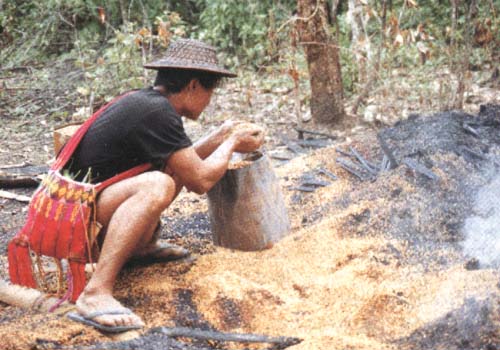
Picture 35: Each smouldering grain of rice recovered from
the ashes of war testifies to the farmer’s
resilience.
|
After scrutinizing the evidence, we
arrived at certain tentative conclusions. Following the
principles of natural justice, we invited the Government
of Myanmar to respond before giving our final verdict. By
our letter dated 23 June 1999 addressed to H. E. Senior
General Than Shwe, Prime Minister of The Government of
the Union of Myanmar, we announced certain preliminary
conclusions, all indicating that there has in fact been
denial of food, largely through the actions of
government. 34 We
requested the government to reply by the end of July,
after which time the Tribunal would finalize its verdict.
The letter was delivered, but we received no response
whatsoever. Given this failure to reply, we are free to
proceed with our findings. If sometime in the future the
Government changes heart and submits evidence, it can be
included in any future proceedings or reports. |
| 1 |
 |
A catalogue of material submitted to
the Tribunal, witness deposition, testimonies, and a
bibliography are attached as Appendices 2,3, 4 and 7
respectively. |
| 2 |
 |
Saw Kwe Say, Report on the
Conditions in Free Fire Zones of Mudraw and Mone
Townships, 1996. |
| 3 |
 |
AHRC, First Submission to the
People’s Tribunal on Food Scarcity and
Militarization in Burma, 1 February 1999, p. 73. |
| 4 |
 |
"Confidential Report to Burma
Issues on taxation and extortion of villages in Kyauk Kyi
Township, Pegu Division," 17 October 1998. |
| 5 |
 |
Karen Human Rights Group, Wholesale
Destruction: The SLORC/SPDC Campaign to Obliterate All
Hill Villages in Papun and Eastern Nyaunglebin Districts,
Chiang Mai: Nopburee Press, April 1998. |
| 6 |
 |
AHRC, p. 73. |
| 7 |
 |
See "The mountains of war," Testimony 1, Appendix 4. |
| 8 |
 |
See "War and hunger in the
1990s," Testimony 2, Appendix 4. |
| 9 |
 |
See "A village teacher," Testimony 4, Appendix 4. |
| 10 |
 |
See the First Witness’
deposition, Appendix 3. |
| 11 |
 |
See the First Witness’
deposition,Appendix 3. |
| 12 |
 |
See "Forced Relocation," Testimony 23, Appendix 4. |
| 13 |
 |
Adapted from Terror in the South:
Militarisation, Economics and Human Rights in Southern
Burma, All Burma Students Democratic Front, November
1997 |
| 14 |
 |
See "Wandering in the
jungle," Testimony 13, Appendix 4. |
| 15 |
 |
See "No living things," Testimony 14, Appendix 4. |
| 16 |
 |
International Labour Organisation,
"Forced Labour in Myanmar (Burma). Report of the
Commission of Inquiry appointed under article 26 of the
Constitution of the International Labour Organization to
examine the observance by Myanmar of the Forced Labour
Convention, 1930 (No. 29). Geneva, 1998." |
| 17 |
 |
AHRC, p. 132. |
| 18 |
 |
See "Shouldering the
burden," Testimony 15, Appendix 4. |
| 19 |
 |
AHRC, p. 139 |
| 20 |
 |
See "Forced relocation," Testimony
23, Appendix 4. |
| 21 |
 |
Win Hlaing, "Tenasserim Division:
Thayet Chaung /Ye Pyu Townships Rural Conditions,"
25 October 1998 |
| 22 |
 |
See "The reality of agricultural
development," Testimony 24, Appendix 4. |
| 23 |
 |
The New Light of Myanmar, 27
March 1995, reported on the dam's inauguration. It was
later covered in "Minister for A&I inspects
Ngamoeyeik Dam, paddy fields in Bago Division," New
Light of Myanmar, 6 September 1998. |
| 24 |
 |
AHRC, p.181. |
| 25 |
 |
Human Rights Watch/Asia; Refugees
International, Bangladesh/Burma – Rohingya
Refugees in Bangladesh: The Search for a Lasting Solution,
August 1997, pp. 11-12. Further information on food
scarcity can be found in "Rohingya said to be
fleeing famine," The Nation, 11 May 1997 and
Rohingya Solidarity Organisation, "Starvation Looms
in Arakan," Newsletter, April 1997. |
| 26 |
 |
See "Food scarcity in the
delta," Testimony 26, Appendix 4. |
| 27 |
 |
American Embassy Rangoon, p. 33. |
| 28 |
 |
"The Inside Perspective," Burma
Issues, January 1997. |
| 29 |
 |
AHRC, p. 186. |
| 30 |
 |
National Coalition Government of the
Union of Burma, Human Rights Yearbook 1996, July
1997, p. 221. |
| 31 |
 |
Mya Maung, "The State of the
Burmese Economy under Military Management," in Human
Rights Yearbook 1995, National Coalition Government
of the Union of Burma, May 1996, p. 33. |
| 32 |
 |
Confidential Report to Burma
Issues, July 1997. |
| 33 |
 |
Mon Information Service (Bangkok), Abuses
Against Peasant Farmers in Burma, July 1998. |
| 34 |
 |
The letter is attached here as Appendix
1. |
Return
to Top
|